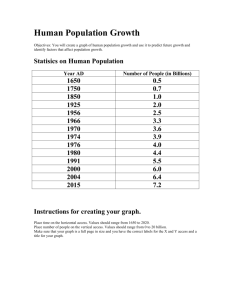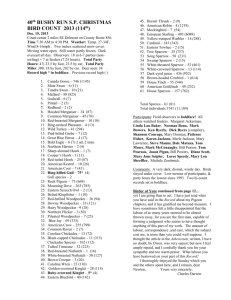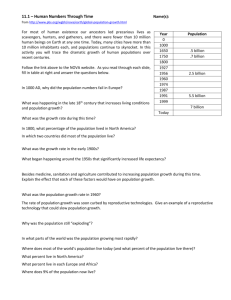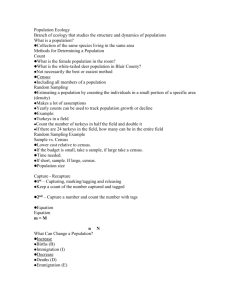Population Ecology Simulation
advertisement
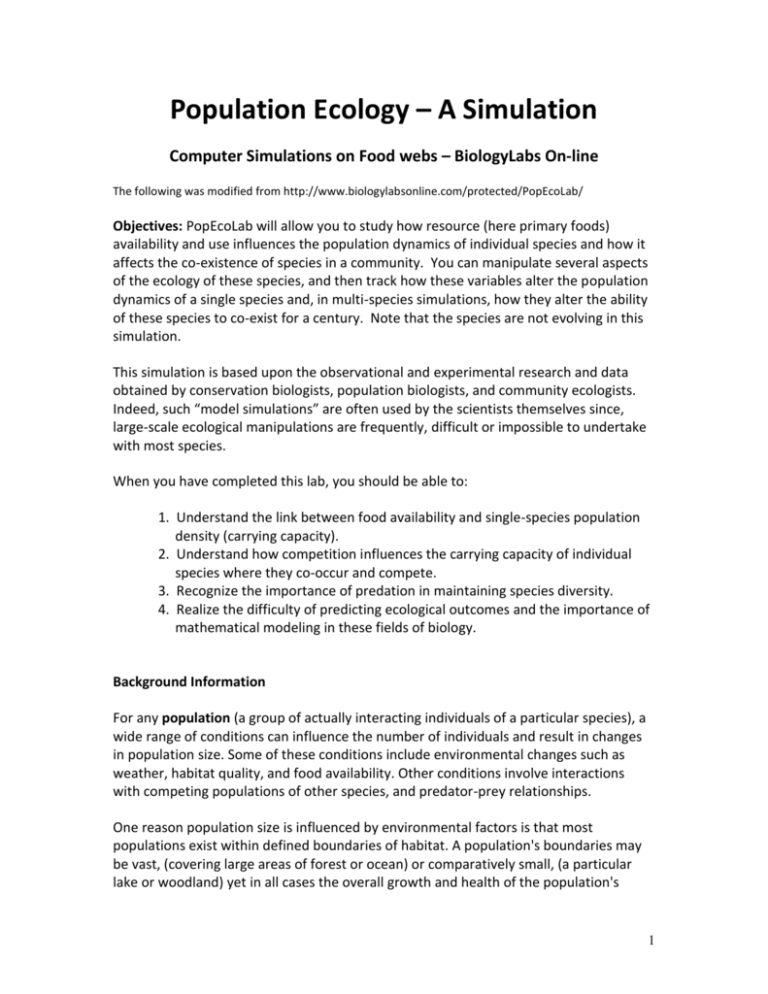
Population Ecology – A Simulation Computer Simulations on Food webs – BiologyLabs On-line The following was modified from http://www.biologylabsonline.com/protected/PopEcoLab/ Objectives: PopEcoLab will allow you to study how resource (here primary foods) availability and use influences the population dynamics of individual species and how it affects the co-existence of species in a community. You can manipulate several aspects of the ecology of these species, and then track how these variables alter the population dynamics of a single species and, in multi-species simulations, how they alter the ability of these species to co-exist for a century. Note that the species are not evolving in this simulation. This simulation is based upon the observational and experimental research and data obtained by conservation biologists, population biologists, and community ecologists. Indeed, such “model simulations” are often used by the scientists themselves since, large-scale ecological manipulations are frequently, difficult or impossible to undertake with most species. When you have completed this lab, you should be able to: 1. Understand the link between food availability and single-species population density (carrying capacity). 2. Understand how competition influences the carrying capacity of individual species where they co-occur and compete. 3. Recognize the importance of predation in maintaining species diversity. 4. Realize the difficulty of predicting ecological outcomes and the importance of mathematical modeling in these fields of biology. Background Information For any population (a group of actually interacting individuals of a particular species), a wide range of conditions can influence the number of individuals and result in changes in population size. Some of these conditions include environmental changes such as weather, habitat quality, and food availability. Other conditions involve interactions with competing populations of other species, and predator-prey relationships. One reason population size is influenced by environmental factors is that most populations exist within defined boundaries of habitat. A population's boundaries may be vast, (covering large areas of forest or ocean) or comparatively small, (a particular lake or woodland) yet in all cases the overall growth and health of the population's 1 individuals is directly influenced by the geographical boundaries of the population. This is true in part because the boundaries of habitat in which a population resides define a finite carrying capacity (the maximum population size that a geographical area can support) as dictated by available resources such as food and shelter. If the local food supply is inadequate a population may exceed the carrying capacity of a geographical area. This can result in diverse responses by its members. Sometimes the response results in increased carrying capacity, such as the addition of alternative food sources. However, most responses result in a decline in the population size. Individuals may leave the area (emigrate) in search of a richer food supply, they may reduce their reproductive rate (number of offspring per individual) or suffer an increased death rate. In some cases, exceeding carrying capacity can lead to extinction of a species. Often, exceeding the carrying capacity leads to a decline in the quality of the habitat so that when the population recovers, it has a new, lower carrying capacity. In many communities (groups of interacting populations inhabiting the same geographic region), competition for a common food supply will influence the population size of all the competitors. Theoretically, two species competing for exactly the same limited resources cannot coexist. This concept is known as the competitive exclusion principle. When two species have partial overlap of resource requirements, “interspecific competition” will occur and each species will lower the carrying capacity of the other. Even under conditions of moderate population size, adequate habitat and food supply, and reasonable birth and death rates, populations must deal with predation. Such predation will lower the population numbers below the carrying capacity (although some biologists consider carrying capacity of an environment to include the impact of predation, most consider carrying capacity to refer only to the resources available to the species being considered). Predator-prey relationships influence both the prey and the predator; the prey species form part of the resource base that determines the carrying capacity of the predator species. Predation is often a mechanism that prevents prey populations from exceeding the carrying capacity of the habitat, and may be important in maintaining diversity of prey species if the predators are generalists that eat prey in proportion to their availability. Biologists study these relationships by carefully designed observational studies over extended periods of time, documenting resource availability, population growth rates, and competitive and predatory relationships. Experimental studies are more difficult to do with complex communities because of the number of potentially important interactions. For this reason, theoretical models and simulations are very important for our understanding of community structure and habitat management. In this exercise you will study important aspects of population ecology; population dynamics for a single species, dynamics of competition, and the influence of predation. In addition this laboratory may help you to better understand the problems that confront conservation biologists, as you seek to establish a conservation program that will allow a rare sparrow species to survive in the face of strong competition and predation. 2 Experiment 1: Single species population dynamics A. Run the experiment with the default settings; Here, only one of the two sparrow species is present. The output we are concerned with in this lab is the plot of population size versus time. In table 1, note which sparrow you are working with, the input food densities and the average population size after the population reaches the carrying capacity (place the cursor over the plot to see density at any time). We expect population size to be tightly regulated by food availability. To test this hypothesis, run the simulation a second time with food availability (Resource Densities-both types) reduced by 50%, and a third time with food availability increased by 50%. Table 1a: Single species:___________ Initial population size:______ Food availability: seeds Food availability: insects Carrying capacity B. These sparrows may not rely equally on both food sources. How might that fact affect the outcome? Predict which food-source your sparrow species is primarily dependent upon? Now restate the hypothesis above by considering only one of the two food sources (do not alter the food usage (rate) by your species): Rerun the experiment varying only the food source upon which you based your hypothesis, (return the alternate food to its default amount) entering the results in Table 1b. Do the results support or refute your hypothesis? Table 1b: Single species __________Initial population size:_______ Food availability: seeds Food availability: insects Carrying capacity 3 Experiment 2: Competition without predation 2a. Here, you will be working with two sparrow species. Although they may have different food preferences, they do have the ability to use either source if necessary. In a limited habitat this can lead to “interspecific competition” as noted above. Return the food levels to 100 seeds (or insects) per square meter. You will be inserting the second sparrow species (with distinct food preferences) into the simulation and leaving the competition level at 0.50. Turn on “multiple run mode” and choose to run the experiment 5 times. A table will appear that allows you to set the initial population size for each species for each run: set the population sizes for blue and brown sparrow to 100 (total initial sparrow density of 200); leave the hawk population at 0. Examine the results for the first run: What is the carrying capacity for each of the two species? Examine the results for the other runs. How consistent are the results across runs? 2b. Propose an hypothesis for how a shift in the intensity of competition influences the carrying capacity of each species (in other words, if both species used the same food at the same rate, how would their population dynamics change?). Write your hypothesis here: Keeping all other inputs the same (and keeping it to 5 runs), shift the competitive interactions on both species to 1.0. Write your predicted outcome here: Run the experiment and observe the output for run 1. Do these results agree with your prediction and therefore support your hypothesis? Examine the results for each of the 5 runs. Are they consistent with what you saw for run 1? Briefly compare the different runs: 4 2c. Propose an hypothesis for how a shift in relative competitive abilities influences the carrying capacity of each species (in other words, if one species was better able to use both food sources and the other species was more dependent upon only one food, how would their population dynamics shift?). Write your hypothesis here: Test your hypothesis by setting the competitive interaction of one species to 1.0 and of the other species to 0.5. Briefly describe what you expect to see happen (your prediction) for this run of the experiment; include in this prediction a statement of how consistent you expect the results to be across the multiple runs. Examine the results for each of the 5 runs. Do they support or refute your hypothesis? How are these results different from what you observed in Experiment 2b? Experiment 3: Coexistence of species. The above results reflect what conservation biologists are often faced with. As usable habitat areas become smaller, species that previously subdivided the environment into geographically distinct habitat patches are forced to co-exist in overlapping areas, which induces new competition. It is also the situation that biologists must manage when a strong competitor invades the habitat (such as the invasion of the US by starlings, which had a strong negative effect on many cavity-nesting birds like blue martins). One of the common short-term solutions is to manipulate food sources to try to preserve the “rare” or threatened species while other conservation methods are devised. Examining your results from Experiment 2c, identify each species as “rare” or “dominant”. Your goal will be to manipulate the habitat and the biological community in a way that will maintain the rare species in the face of the competition by the dominant species. In the short term, we will attempt to maintain the rare species by providing extra food. Hypothesize here which of the two food sources must be augmented in order to allow both species to survive: Leaving all other settings the same, and keeping 5 runs, double the amount of the food you hypothesize to be important. Enter your results in table 2; Here, “persistence” is the number of years to extinction. If a species does not go extinct, enter “infinity”. 5 Table 2: Rare species_____________Initial population size 100 Dominant species____________ Initial population size 100 Food level seeds_________ insects________ run blue sparrow persistence brown sparrow persistence 1 2 3 4 5 How good were you at choosing the “right” food to supplement? How reliable were the results from run to run (what proportion of the runs did the rare species go extinct?). Experiment 4: The importance of predators. One long-term solution to maintaining species diversity among species that compete is to reintroduce a predator (assuming that one occurs there and has gone locally extinct). Such situations are referred to as “top-down” community regulation, in contrast to the food supplementation, which is described as “bottom-up” community regulation. It is believed that a predator that consumes various prey will attack the most common prey item more frequently simply because it encounters this species more frequently. Theoretically, this should reduce the population of the strong competitor enough to allow the rare species to persist. In this simulation, we have the ability to introduce a hawk that will eat both sparrows; if the settings for flight speed are left equal then the hawk will capture both species equally well. We are going to test the hypothesis that introducing this hawk will allow the rare species to persist. 6 Start by returning food availabilities to 100 units/m2 (why?). In the table for “multiple runs”, increase the number of runs to 10 and add hawks to each run. Choose two different initial densities of hawks, running 5 replicates of each. Record in Table 3 the number of hawks you introduce in each run. When you examine your results, note that the red line is the hawk population size. If you see no red line then the hawks failed to successfully establish a population. Table 3 run 1 N. hawks blue persistence brown persistence hawk persistence 2 3 4 5 6 7 8 9 10 Examine your results. In what percentage of the runs, for each hawk introduction level, have all three species survived? How did the introduction of the hawks influence the persistence of the rare species? Compare your results with results of your classmates that ran different initial hawk population sizes. How did the number of hawks introduced alter the likelihood that the hawk became established in the community? How did the establishment of hawks alter the likelihood that both sparrow species persisted 100 years? 7 Experiment 5: Allowing evolution In all of these simulations, we have prevented evolution from happening: there have been no shifts in physiological factors such as clutch size, life span, or flight speed that in real life might increase fitness in the rare species and thus increase the likelihood that the species would persist. Choose one of these parameters, and predict how an evolutionary change (increase or decrease) in that parameter would increase the likelihood of persistence of the rare species in the community: Choose an initial setting for this input parameter, and record it in table 4. Be sure to only alter one parameter only in the rare species, and to leave all other parameters as they were set in Experiment 4 (after choosing one hawk population size to use). Adjust the input parameter accordingly and run 10 replicates. Hawk initial population________ Rare species initial population 100 In table 4, record the initial settings for your run, and the proportion of runs that end at 100 years with the persistence of all three, bird species. Repeat the simulation with four other settings of this parameter. Table 4: Varying ___________ in the rare sparrow Parameter setting % runs with 3 species persisting How strong a change in the physiological parameter is required for the rare species to persist? At any settings, did the relationship between the two sparrow species reverse (with the “rare” species becoming the dominant one)? 8 If you did observe a reversal in the competitive relationships, can you determine what the “break point” was where this occurred? Finally, what is the strategy that is most likely to result in the maintenance of all three species (two sparrows and the hawk) in the community? References/Acknowledgments 1. Bush, M. B. Ecology of a Changing Planet, 2nd ed. Upper Saddle River, NJ: Prentice Hall, 2000. 2. Caswell, H. Predator-Mediated Coexistence: A Non-Equilibrium Model." American Naturalist, 112 (1978). 3. Rosenweig, M. L. Stability of Enriched Aquatic Ecosystems. Science, 175 (1972). 4. Smith, R. L., and Smith, T. M. Elements of Ecology, 4th ed. San Francisco: Benjamin/Cummings, 2000. 5. UVM acknowledges the work of Dr. Linden Higgins in preparing this simulation for use in the introductory course sequence. 9




